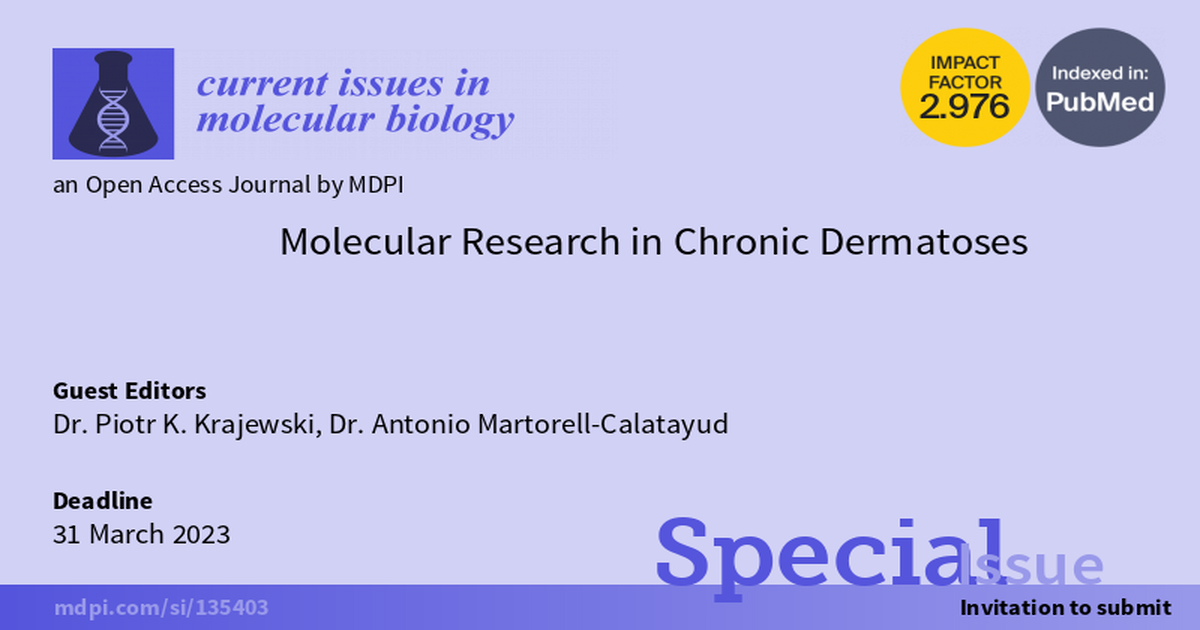Molecular Research in Chronic Dermatoses
A special issue of Current Issues in Molecular Biology (ISSN 1467-3045). This special issue belongs to the section "Molecular Medicine".
Deadline for manuscript submissions: closed (30 November 2023) | Viewed by 17157

Special Issue Editors
Interests: skin; allergic contact dermatitis; hidradenitis suppurativa; inflammatory skin disorders; psoriasis; atopic dermatitis; dermatosurgery; dermato-oncology; itch; skin biology; molecular biology; genetics
Special Issues, Collections and Topics in MDPI journals
Interests: melanoma; clinical dermatology; cancer biomarkers; basal cell carcinoma; psoriasis; dermatopathology; dermatosurgery; skin biology; cosmetology
Special Issues, Collections and Topics in MDPI journals
Special Issue Information
Dear Colleagues,
Chronic inflammatory dermatoses are a group of skin disorders characterized by recurrent and debilitating course and destructive influence on patients’ quality of life. The pathogenesis of most of them is not fully understood. Therefore, treatment is challenging both for physicians and their patients, and the outcome is often unsatisfactory.
In recent years, outstanding progress in understanding the molecular mechanisms behind the pathogenesis of inflammatory dermatoses has been achieved. Studies have led to the development of new therapies, including biologics (chimeric, humanized, and human monoclonal antibodies) and their biosimilars, as well as systemic and topical small molecules (e.g., JAK inhibitors), which have revolutionized the management of patients suffering from chronic inflammatory dermatoses.
Nevertheless, there are still many unmet needs of currently available therapies. The insufficient availability and the high price of biologics impede their use in lower-income communities, while the adverse effects of JAK inhibitors may make physicians hesitant about their prolonged use. Therefore, there is still a significant need for future molecular research explaining the pathogenetic mechanisms leading to the development of skin lesions. In the future, these findings may build a foundation for new, targeted therapies, as well as for predicting disease course and its severity.
This Special Issue entitled “Molecular Research in Chronic Dermatoses” is now open for submission. Our aim is to publish state-of-the-art articles about the molecular mechanisms in, among others, hidradenitis suppurativa, psoriasis, atopic dermatitis, alopecia areata, vitiligo, and chronic spontaneous urticaria. This Special Issue will accept review articles, original research, and updated information on the pathophysiology and molecular pathways.
Dr. Piotr K. Krajewski
Dr. Antonio Martorell-Calatayud
Guest Editors
Manuscript Submission Information
Manuscripts should be submitted online at www.mdpi.com by registering and logging in to this website. Once you are registered, click here to go to the submission form. Manuscripts can be submitted until the deadline. All submissions that pass pre-check are peer-reviewed. Accepted papers will be published continuously in the journal (as soon as accepted) and will be listed together on the special issue website. Research articles, review articles as well as short communications are invited. For planned papers, a title and short abstract (about 100 words) can be sent to the Editorial Office for announcement on this website.
Submitted manuscripts should not have been published previously, nor be under consideration for publication elsewhere (except conference proceedings papers). All manuscripts are thoroughly refereed through a single-blind peer-review process. A guide for authors and other relevant information for submission of manuscripts is available on the Instructions for Authors page. Current Issues in Molecular Biology is an international peer-reviewed open access monthly journal published by MDPI.
Please visit the Instructions for Authors page before submitting a manuscript. The Article Processing Charge (APC) for publication in this open access journal is 2200 CHF (Swiss Francs). Submitted papers should be well formatted and use good English. Authors may use MDPI's English editing service prior to publication or during author revisions.
Keywords
- dermatopathology
- dermatosurgery
- skin biology
- molecular biology
- genetics
Benefits of Publishing in a Special Issue
- Ease of navigation: Grouping papers by topic helps scholars navigate broad scope journals more efficiently.
- Greater discoverability: Special Issues support the reach and impact of scientific research. Articles in Special Issues are more discoverable and cited more frequently.
- Expansion of research network: Special Issues facilitate connections among authors, fostering scientific collaborations.
- External promotion: Articles in Special Issues are often promoted through the journal's social media, increasing their visibility.
- e-Book format: Special Issues with more than 10 articles can be published as dedicated e-books, ensuring wide and rapid dissemination.
Further information on MDPI's Special Issue polices can be found here.






